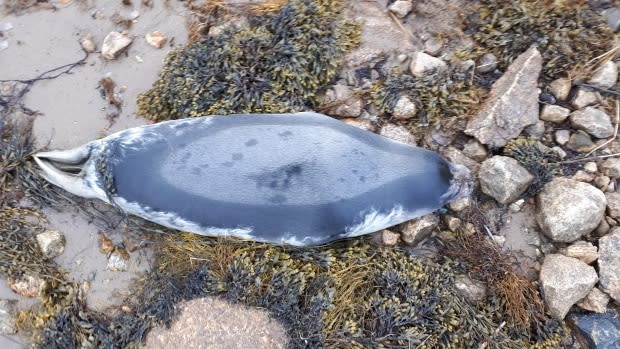Hundreds of dead seals washing ashore in Nova Scotia
Hundreds of dead seals have washed up on shores in Cape Breton and near Halifax in recent days, prompting an investigation by the Marine Animal Response Society.
Andrew Reid, the society's response co-ordinator, said it has received a number of reports over the last week about juvenile seal carcasses washing ashore in Cape Breton and Sambro, N.S., just outside Halifax.
Reid said there are believed to be several hundred dead seals in total, including roughly 70 in the Sambro area.
Eleven washed up on Geoffrey Howard's family property in West Pennant, just outside of Sambro. He said he went out to look after hearing his neighbour counted 27 along the shoreline on his property.
Most of the seals were within about 10 metres of each other. He said the sight was "mysterious."
"What natural occurrence could have caused so many seals to wash up at once? It wasn't so much fear, it was more curiosity," he said.
Reid said they are quite decomposed, but it does appear they are harp seals.
"These would have been born further north, so it's likely they're washing in from up north," said Reid, adding that it's unclear how long the seals have been dead.
The flesh from the head and upper torso has been removed from many of the seals, but the skull is still attached or sometimes found nearby.
Necropsies will be conducted to try to determine the cause of death.
Carcasses are being frozen, as the work can not be performed at this time because of the COVID-19 pandemic.

But Reid said there are a few theories as to what happened to the seals.
"This does happen occasionally, depending on the year," he said.
Reid said pack ice, where the seals are born, could have shifted and crushed the young seals.
It's also possible other animals such as Greenland sharks or grey seals could have preyed upon them.
He said it doesn't appear the seals were killed as part of a seal hunt, as their skulls are intact and have not been crushed.
"Those are all things we would look for signs of in a necropsy and then rule each one out and hopefully be left with the right answer," said Reid.
Reid said the society is interested in collecting more carcasses. He encouraged anyone who finds a seal carcass to call the organization and send photos.
MORE TOP STORIES

